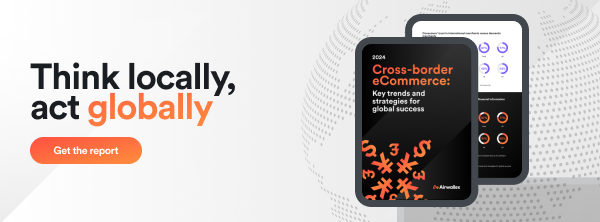A guide: How to expand your business internationally

Annette Rowena
Author

As a business owner, have you thought about expanding your operations beyond your shores? The global eCommerce market is enticing businesses to venture across borders, and the allure is clear. According to Statista, 52% of global online shoppers purchase from overseas and local retailers, signalling a robust appetite for shopping online. The industry value is projected to reach an impressive US$7.9 trillion by 2030. Mobiloud reports that China is leading the global eCommerce market, with annual sales exceeding US$3 trillion, followed by the United States at S$1 trillion.
If you're looking to sell globally, this comprehensive guide based on insights from our latest whitepaper, "Cross-border eCommerce: Key trends and strategies for global success in 2024", will help you set sail with confidence. Examine online shopping trends, customer shopping behaviours, and payment preferences, including how to manage cross-border challenges such as payment risks and more.
Step #1: The importance of market research
Before going international, thorough market research is crucial. From social media trends to local payment preferences, understanding each market's specifics enables you to tailor your business strategy, minimising risks and boosting your chances of success. With in-depth research, you can uncover key insights such as market size and growth potential, competition landscape, and necessary regulations for the target market.
Market research is more than just collecting data; it's about understanding what consumers want, how they discover brands, where they shop, and the cultural differences that affect buying decisions. Our research shows that by using a local, data-focused strategy for user experience, merchants can connect better with global customers, build trust and ultimately grow their cross-border profits.
Step #2: Legal and regulatory considerations
When managing global business operations, your business must meet legal and regulatory requirements that vary by market to avoid financial penalties, legal disputes, and reputational damage. Complying with these regulations has a ripple effect, as it builds trust with your customers and enhances your growth opportunity in the new markets. It's crucial to stay informed about international laws, develop robust compliance programs, and use technology to make compliance easier. Regular audits and consulting with legal experts are key to proactively managing potential risks. By fostering a culture of compliance and ensuring transparency, you can steer clear of legal issues, build trust with your customers, and achieve sustainable growth in various markets.
Step #3: eCommerce platforms and localisation
Your online presence must cater to different market preferences and expectations. This means localising your content, currency, and payment options to create a seamless user experience. Translating your website and product descriptions into the native languages of your target markets is the first step.
Next, your global customers should be able to pay in their local currency using their preferred payment methods. According to our report, 93% of customers claim that seeing a product priced in their local currency impacts their decision to purchase. For example, UnionPay is a popular choice among Chinese customers, but this is not the same in the US. When integrating with a payment gateway, the key is to create a frictionless buying experience so you can accept cross-border payments in multiple currencies quickly and securely.
Step #4: Timely logistics and shipping
Merchants should invest in world-class logistics solutions to optimise their shipping, returns, and refunds processes since consumers expect timely delivery of products, even from international retailers. In our study, 47% of consumers say that lengthy refunding processing times present a challenge when shopping online from an international merchant.
As a merchant operating across borders, you face additional challenges such as variable shipping costs, delivery schedules, and the complexities of handling returns.To handle this efficiently, consider setting up logistic solutions to expedite shipping and working with third-party logistics companies that have the infrastructure to enable efficient returns and refunds processes.
Step #5: Effective payment risk management
Global sales come with an increased risk of fraudulent transactions. It's essential to have robust payment risk management strategies in place to protect your business and your customers. When it comes to enabling secure payment processing, businesses need to strike a balance between facilitating successful transactions and mitigating fraudulent ones, which is where understanding your payment risk appetite comes into play.
By using risk analytics offered by certain eCommerce platforms or payment gateways, you gain insights into fraud trends, spotting patterns and anomalies. This strengthens your payment risk management via targeted measures to prevent fraud before it occurs.
Additionally, incorporating risk watchlists into payment processes helps by shifting liability for potential fraud transactions to the cardholder's issuing bank or blocking suspicious transactions altogether. Using a payment acceptance platform with a robust fraud engine capability which includes these features can safeguard your business from financial losses and reputational damage in the long run.
Step #6: Seamless customer support and communication
International customers have unique needs compared to domestic ones. Providing support in multiple languages across a timezone that may be different from yours and understanding cultural differences can give you an edge over competitors. Our research shows that businesses that focus on creating seamless experiences for both international and domestic customers are more likely to succeed.
To improve customer satisfaction and meet their needs, it's important to ensure your support team speaks the languages of your target markets. This might mean training current staff, hiring multilingual team members, or working with a local call centre. Also, providing support through various channels like email, phone, chat, and social media helps meet the varied preferences of global customers.
Step #7: Curated marketing strategies
When it comes to expanding your reach to international customers, social media serves as a powerful tool. From understanding the most popular social media channels in the market you’re entering to creating targeted content for diverse audiences, social media opens up avenues to connect with global customers effectively.
Additionally, social media's unique strength lies in its capacity to guide customers through every stage of their journey on a single platform. In fact, our report reveals that Facebook dominates as the leading social media channel for cross-border shopping globally except China and Singapore, where TikTok leads instead.
Moreover, in various markets, 75% of consumers indicated that endorsements from international influencers significantly influence their trust in foreign merchants and ultimately, their purchasing decisions on social media platforms.
Whether you choose to sell to your customers by leveraging influencers, or whether you decide to integrate payment links on your social media storefront, social media channels can help you capture international customers in new frontiers and broaden your business's global presence.
Step #8: Maximising financial efficiency
Every cent counts in ensuring the success of your international expansion, including crucial aspects like obtaining best-in-value forex rates and establishing competitive pricing strategies across diverse markets. Understanding and managing these financial intricacies are essential to be financially resilient and competitive.
Airwallex's global business account is a solution, as it allows businesses of any size to open domestic and foreign currency accounts easily without the hassle and complexity usually involved in opening bank accounts. Businesses can manage, hold, and receive payments in various currencies from marketplaces such as Amazon and Alibaba. As there are no high currency conversion fees or hidden costs in the way, it becomes possible to maximise your international sales revenue and achieve steady growth across borders.
Navigating success in global eCommerce
In conclusion, succeeding in the global eCommerce landscape requires diligent planning, navigation of cultural sensitivities, and an understanding of the financial complexities. An established payment partner can solve the payment challenges faced by growing eCommerce businesses by delivering simplified currency conversions, ensuring compliance with local regulations, and providing competitive transaction fees and rates, making it easier for businesses like yours to focus on growth and customer satisfaction.
Get the latest insights into global market trends and eCommerce strategies
If you're looking to dive deeper and understand how to use global eCommerce to grow your business, our detailed whitepaper “Cross-border eCommerce: Key trends and strategies for global success in 2024” provides useful tips and strategies on how to connect, engage, and retain customers across markets. Start your journey to global expansion with the right knowledge and tools for success!


Annette Rowena
Author
Annette Rowena is a seasoned writer who uses financial knowledge and engaging storytelling to simplify complex fintech topics.
Posted in:
Business bankingShare
- Step #1: The importance of market research
- Step #2: Legal and regulatory considerations
- Step #3: eCommerce platforms and localisation
- Step #4: Timely logistics and shipping
- Step #5: Effective payment risk management
- Step #6: Seamless customer support and communication
- Step #7: Curated marketing strategies
- Step #8: Maximising financial efficiency
- Navigating success in global eCommerce
- Get the latest insights into global market trends and eCommerce strategies


